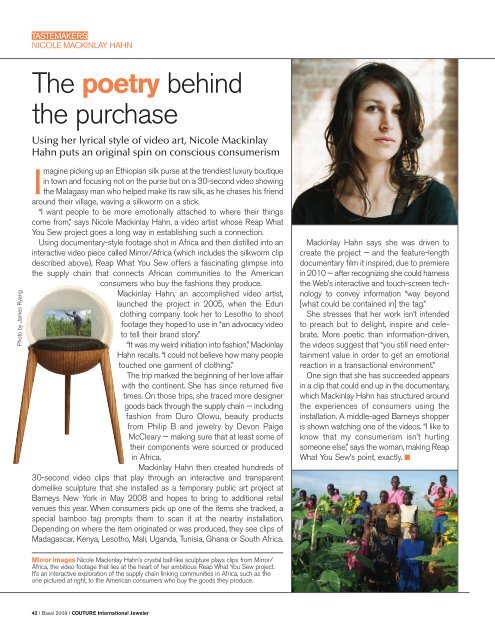FOR iPad > OPEN IN IBOOKS - CIJintl.com
FOR iPad > OPEN IN IBOOKS - CIJintl.com
FOR iPad > OPEN IN IBOOKS - CIJintl.com
You also want an ePaper? Increase the reach of your titles
YUMPU automatically turns print PDFs into web optimized ePapers that Google loves.
Photo by James Ryang<br />
TASTEMAKERS<br />
NICOLE MACK<strong>IN</strong>LAY HAHN<br />
The poetry behind<br />
the purchase<br />
Using her lyrical style of video art, Nicole Mackinlay<br />
Hahn puts an original spin on conscious consumerism<br />
Imagine picking up an Ethiopian silk purse at the trendiest luxury boutique<br />
in town and focusing not on the purse but on a 30-second video showing<br />
the Malagasy man who helped make its raw silk, as he chases his friend<br />
around their village, waving a silkworm on a stick.<br />
“I want people to be more emotionally attached to where their things<br />
<strong>com</strong>e from,” says Nicole Mackinlay Hahn, a video artist whose Reap What<br />
You Sew project goes a long way in establishing such a connection.<br />
Using documentary-style footage shot in Africa and then distilled into an<br />
interactive video piece called Mirror/Africa (which includes the silkworm clip<br />
described above), Reap What You Sew offers a fascinating glimpse into<br />
the supply chain that connects African <strong>com</strong>munities to the American<br />
consumers who buy the fashions they produce.<br />
Mackinlay Hahn, an ac<strong>com</strong>plished video artist,<br />
launched the project in 2005, when the Edun<br />
clothing <strong>com</strong>pany took her to Lesotho to shoot<br />
footage they hoped to use in “an advocacy video<br />
to tell their brand story.”<br />
“It was my weird initiation into fashion,” Mackinlay<br />
Hahn recalls. “I could not believe how many people<br />
touched one garment of clothing.”<br />
The trip marked the beginning of her love affair<br />
with the continent. She has since returned five<br />
times. On those trips, she traced more designer<br />
goods back through the supply chain — including<br />
fashion from Duro Olowu, beauty products<br />
from Philip B and jewelry by Devon Paige<br />
McCleary — making sure that at least some of<br />
their <strong>com</strong>ponents were sourced or produced<br />
in Africa.<br />
Mackinlay Hahn then created hundreds of<br />
30-second video clips that play through an interactive and transparent<br />
domelike sculpture that she installed as a temporary public art project at<br />
Barneys New York in May 2008 and hopes to bring to additional retail<br />
venues this year. When consumers pick up one of the items she tracked, a<br />
special bamboo tag prompts them to scan it at the nearby installation.<br />
Depending on where the item originated or was produced, they see clips of<br />
Madagascar, Kenya, Lesotho, Mali, Uganda, Tunisia, Ghana or South Africa.<br />
Mirror images Nicole Mackinlay Hahn’s crystal ball-like sculpture plays clips from Mirror/<br />
Africa, the video footage that lies at the heart of her ambitious Reap What You Sew project.<br />
It’s an interactive exploration of the supply chain linking <strong>com</strong>munities in Africa, such as the<br />
one pictured at right, to the American consumers who buy the goods they produce.<br />
42 l Basel 2009 l COUTURE International Jeweler<br />
Mackinlay Hahn says she was driven to<br />
create the project — and the feature-length<br />
documentary film it inspired, due to premiere<br />
in 2010 — after recognizing she could harness<br />
the Web’s interactive and touch-screen technology<br />
to convey information “way beyond<br />
[what could be contained in] the tag.”<br />
She stresses that her work isn’t intended<br />
to preach but to delight, inspire and celebrate.<br />
More poetic than information-driven,<br />
the videos suggest that “you still need entertainment<br />
value in order to get an emotional<br />
reaction in a transactional environment.”<br />
One sign that she has succeeded appears<br />
in a clip that could end up in the documentary,<br />
which Mackinlay Hahn has structured around<br />
the experiences of consumers using the<br />
installation. A middle-aged Barneys shopper<br />
is shown watching one of the videos. “I like to<br />
know that my consumerism isn’t hurting<br />
someone else,” says the woman, making Reap<br />
What You Sew’s point, exactly. ■



